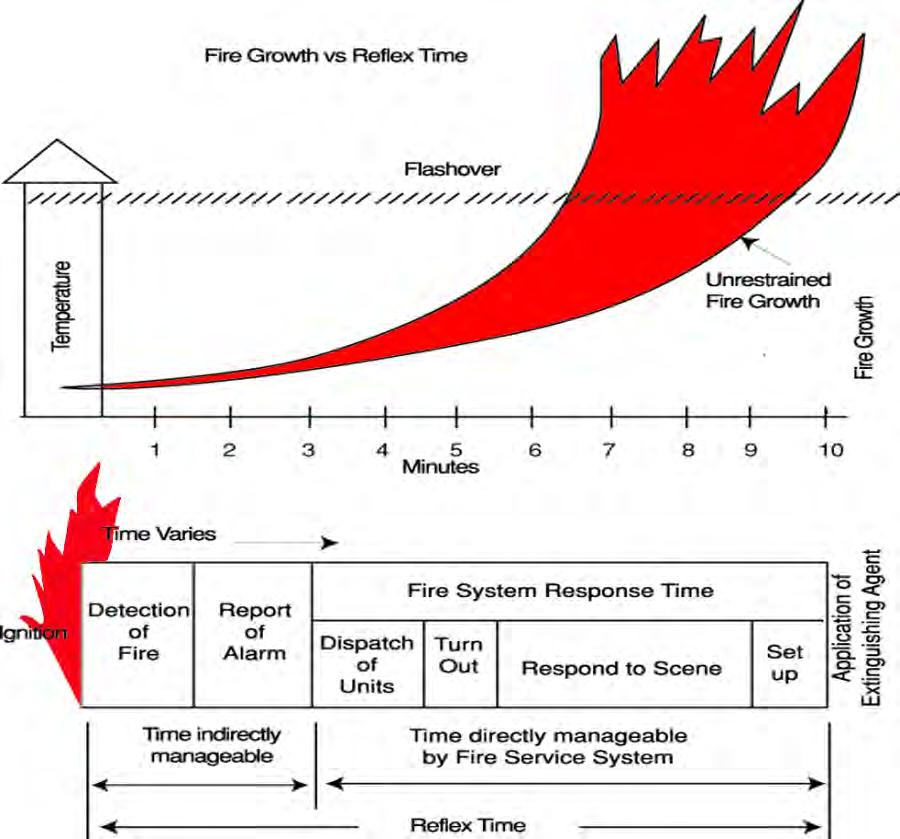
4 minute read
Dynamics of Fire in Buildings
Establishment of Performance Objectives
There are three main factors the lead to successful mitigation of emergencies; sufficient numbers of welltrained personnel, arriving on reliable and well-equipped apparatus appropriate to the task at hand, quickly enough to make a positive difference in property preserved or lives saved.
Advertisement
The previous sections of this report have laid out the current staffing levels, facilities and equipment, and response performance for the Southington Fire Department. The following describes the consequences of failing to deliver sufficient personnel and equipment early enough to mitigate the emergency addressed.
Dynamics of Fire in Buildings
Most fires within buildings develop in a predictable fashion unless influenced by highly flammable material. Ignition, or the beginning of a fire, starts the sequence of events. It may take several minutes or even hours from the time of ignition until a flame is visible. This smoldering stage is very dangerous, especially during times when people are sleeping, since large amounts of highly toxic smoke may be generated during this phase.
Once flames do appear, the sequence continues rapidly. Combustible material adjacent to the flame heat and ignite, which in turn heats and ignites other adjacent materials if sufficient oxygen is present. As the objects burn, heated gases accumulate at the ceiling of the room. Some of the gases are flammable and highly toxic.
The spread of the fire from this point continues quickly. Soon the flammable gases at the ceiling as well as other combustible material in the room of origin reach ignition temperature. At that point, an event termed “flashover” occurs; the gases and other material ignite, which in turn ignites everything in the room. Once flashover occurs, damage caused by the fire is significant and the environment within the room can no longer support human life. Flashover usually occurs about five to eight minutes from the appearance of flames in typically furnished and ventilated buildings. Since flashover has such a dramatic influence on the outcome of a fire event, the goal of any fire agency is to apply water to a fire before flashover occurs.
Although modern codes tend to make fires in newer structures more infrequent, today’s energy-efficient construction (designed to hold heat during the winter) also tends to confine the heat of a hostile fire. In addition, research has shown that modern furnishings generally ignite more quickly and burn hotter (due to synthetics). In the 1970s, scientists at the National Institute of Standards and Technology found that after a fire broke out, building occupants had about 17 minutes to escape before being overcome by heat and smoke. Today, that estimate is as short as three minutes.25 The necessity of effective early warning (smoke alarms), early suppression (fire sprinklers), and firefighters arriving on the scene of a fire in the shortest span of time is more critical now than ever.
25 National Institute of Standards and Technology, Performance of Home Smoke Alarms, Analysis of the Response of Several Available Technologies in Residential Fire Settings, Bukowski, Richard, et al.
The prompt arrival of at least four personnel is critical for structure fires. Federal regulations (CFR 1910.120) require that personnel entering a building involved in fire must be in groups of two. Further, before personnel can enter a building to extinguish a fire, at least two personnel must be on scene and assigned to conduct search and rescue in case the fire attack crew becomes trapped. This is referred to as the two-in, two-out rule. However, if it is known that victims are trapped inside the building, a rescue attempt can be performed without additional personnel ready to intervene outside the structure. Further, there is no requirement that all four arrive on the same response vehicle. Many fire departments rely on more than one unit arriving to initiate interior fire attack.
Perhaps as important as preventing flashover is the need to control a fire before it does damage to the structural framing of a building. Materials used to construct buildings today are often less fire-resistive than the heavy structural skeletons of older frame buildings. Roof trusses and floor joists are commonly made with lighter materials that are more easily weakened by the effects of fire. “Light weight” roof trusses fail after five to seven minutes of direct flame impingement. Plywood I-beam joists can fail after as little as three minutes of flame contact. This creates a dangerous environment for firefighters.
In addition, the contents of buildings today have a much greater potential for heat production than in the past. The widespread use of plastics in furnishings and other building contents rapidly accelerates fire spread and increases the amount of water needed to effectively control a fire. All these factors make the need for early application of water essential to a successful fire outcome.
The next figure illustrates the sequence of events during the growth of a structure fire over time.



